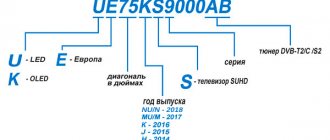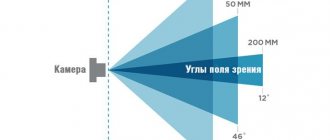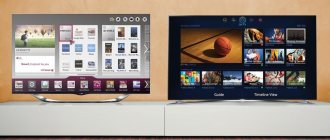It is quite difficult for even many experienced users to understand what types of TV matrices exist, primarily due to the marketing component of the issue. Many brands began to come up with new names to increase demand for new collections of their products. We will try to figure out which TV matrices are better in 2021, taking into account the features and types of technologies.
First of all, you should understand that all LED TVs come in three types:
- TN matrices are the most budget-friendly and no longer relevant type;
- VA matrices – have a fast response, are good for games, but do not have a wide enough viewing angle;
- IPS matrices attract with good color rendering, visibility, balanced price and characteristics.
The best matrices for TVs for 2021
VA and IPS - which matrix is better?
Actually, this confrontation has been going on for many years. Before the advent of premium matrices with organic LEDs, there were only LCD TVs, which are still popular today even in the segment of good 4K TVs.
Relatively speaking, Vertical Alignment (VA) and In-Plane Switching (IPS) work on the same principle: they pass the backlight through tiny liquid crystal structures. In terms of color rendering and brightness, much depends on the specific model, but there are differences in a number of parameters.
Black level
One of the few parameters in which VA matrices clearly lead over their competitors, and produce black color at the level of 0.020-0.015 Nits. For IPS matrices, the brightness level of the black tint is several times worse - around 0.07-0.09 Nits. What does this indicator affect?
- High dynamic range (HDR) display quality;
- Perception of other colors in contrast (general background);
- Overall contrast level.
Color rendering level
In terms of the level of color rendering, it is difficult to identify a clear leader. Still, a lot also depends on the class, and not the type of matrix. So, for example, 10-bit IPS will be better than 8-bit VA, as well as vice versa. The characteristics are also revealed by HDR. In general, today there are many mid-range models with support for more than 1 billion shades.
At the same time, we must not forget about the depth of black color in VA matrices, which is why, with the same color gamut, the picture on such TVs may visually look more saturated.
Playing action scenes
Of course, a lot depends on the frame rate, but by default IPS matrices are better at reproducing dynamic content than VA. Combined with a wide viewing angle, watching sports TV shows or action films is more enjoyable.
At the same time, VA matrices have a lower response speed, which is especially noticeable when connecting a game console to the TV.
Conclusion: which is better IPS or VA?
Comparing IPS and VA TVs, we can draw the following conclusions:
- VA matrix is better suited for gaming monitors and TVs;
- The IPS matrix is better suited for viewing dynamic scenes.
Don’t also forget that each specific line has various image enhancement technologies. Often they play a major role. Our conclusion is subjective.
Screen types
The choice of TV directly depends on the purpose for which the multimedia device is purchased. Will it be intended for home viewing or used during presentations? Having set your priorities and understood the features of displays created using different technologies, you can safely go to the electronics supermarket to make a purchase.
At the moment, outdated models that display a picture on a display board using a cathode ray tube are long gone. CRT TVs have served their useful life, giving way to more advanced options - flat-panel LED and LCD devices.
Liquid crystal screens (LCD technology)
LCD displays have replaced expensive plasma panels. The technology for producing LCD screens is quite simple, so the cost of TVs with such a matrix is low. The image is transmitted using liquid crystal molecules that move along the surface, constantly changing their location. The movement of light fluxes is associated with a significant disadvantage of this type - distortion/blurring of the picture when viewed at an angle and a poor signal. Also, the LCD display does not reflect enough black depth. But, despite the shortcomings, TV models with an LCD matrix are popular. The list of advantages includes:
- High level of image clarity and contrast with a good signal
- Attractive price
- Low power consumption.
LED screens (LED technology)
This category includes televisions that have an LCD screen with LED backlighting. The operation of the matrix is based on a different principle of image reproduction. The transmission of visual information occurs using liquid crystals, which do not glow without voltage. As soon as the light begins to arrive, the picture becomes visible to the human eye. Moreover, the more intense the flow, the brighter the colors. The voltage source is LEDs, which replaced fluorescent lamps. Contour and direct lighting are available. In the first case, many LEDs are located around the perimeter of the display, reflecting light to its center.
Among the advantages of LED TVs are:
- Brightness, clarity, saturation of the image
- Picture quality is not related to viewing angle
- Wide range of sizes
- The screens have become much thinner, allowing them to be mounted to the wall
- Saving electricity.
We can say that this type is an ideal option. However, the cost of such TVs is quite high.
OLED TVs
The latest generation of screens with improved characteristics. The unique image reproduction technology using organic light-emitting diodes allows you to display the image on the display with maximum color and contrast accuracy. Unlike LEDs, LEDs do not require backlighting; on the contrary, they emit it themselves. Therefore, each pixel is illuminated, not the screen. Moreover, the more pixels, the deeper the colors.
Main advantages:
- The thinnest and most elegant options
- Light weight and dimensions
- Instant response when turned on
- Possibility of creating flexible displays
- The image quality is the same at any viewing angle.
Among the disadvantages are the very high cost, sensitivity to moisture, short service life of blue pixels, and a limited model range.
Plasma TVs
Another type of television screen is plasma. The matrix is based on cells filled with gas. Plasma works according to the “initialization-addressing-illumination” principle, resulting in the formation of one subfield of the picture. The combination of several subfields (standard 8 pieces) forms an image of the required brightness and clarity.
Main advantages:
- Affordable price
- Deep, crisp colors
- Increased contrast
- Longer service life compared to LCD panels. On average, 20-30 years, as opposed to 7-10 years for liquid crystal matrices.
The disadvantages include higher electricity consumption and dimensions. Production technology does not allow the creation of models smaller than 32 inches diagonally.
How are NanoCell matrices different from LG?
If you don’t know which matrix to choose for a mid-range TV, then you should pay attention to NanoCell from LG. There are no alternatives in the LED screen segment yet, and the fact that the best LG TVs occupy more than 60% of the European market is proof of this. How does this type of technology differ from IPS and VA?
In fact, NanoCell is an upgraded IPS technology that filters colors much more efficiently, which guarantees a high-quality picture.
In terms of viewing angle and reproduction of dynamic scenes, this technology is in no way inferior to simple LED alternatives.
What is a matrix
The general design of the matrix used in televisions is a system that includes narrow, colorless electrodes. They are placed parallel to each other in the same plane vertically or horizontally. If such a matrix is depicted as a diagram on paper, it will turn out to be a grid with square slots.
The entire set of electrodes is located inside plates made of film or glass. Electrodes located vertically do not touch each other. Thus, the matrix can be schematically represented as a sheet of paper with luminous dots printed on it. Lighting up in a certain sequence, they produce the desired image.
For the manufacture of matrices, special technologies are used that affect the quality of pictures broadcast from the screen. Conventionally, they can be divided into three main types:
- LCD. This technology is used in liquid crystal displays.
- LED. LED backlighting of LCD screens.
- Plasma. A special technology is used. An electric current is passed through the gas, under the influence of which light is emitted.
Currently, liquid crystal structures are considered the cheapest and most economical. In this regard, plasma products have practically already left the electronics market. At the same time, LCD matrices are available in several versions, with different properties and different prices. Despite the apparent commonality of the technology used, the image quality of each type differs significantly.
Why is QLED matrix better than NanoCell?
It’s worth saying right away that QLED technology involves the use of “quantum dots,” which is radically different from liquid crystal LED TVs. This technology was presented by Samsung, positioning its matrices as something excellent and inimitable, but after some time it became clear that the final stages of development are still very, very far away.
QLED matrices are indeed very bright, in which Nano Cell is inferior to them. But it’s difficult to call the matrix ideal, since it’s essentially VA with an additional film between the liquid crystals. In the future, quantum rods may indeed appear, which will allow Samsung's best TVs to compete with competitors' OLED panels, but for now they themselves order other panels for many of their lines. First, QLEDs use a lot of energy. Secondly, due to the additional layer they are larger.
V.A.
VA matrix is a compromise between TN and IPS. It is a popular type of matrix and is used in many modern models of LCD TVs. In VA, the liquid crystals in the off state are perpendicular to the screen plane. This allows for rich blacks that cannot be achieved with TN and IPS. The crystals are able to move freely, so the colors are not distorted when changing the viewing angle. TVs that use VA technology are suitable for rooms with low lighting.
VA matrices are superior to TN in image quality, but they are not good enough compared to IPS. However, in the production of VA, new technologies are gradually being introduced to correct many of the shortcomings of this type of matrix. These technologies include MVA and PVA.
The best matrix of 2021 for TVs is OLED!
In our subjective opinion, the best matrix for TVs is OLED. Such TVs operate on the basis of pixels, each of which represents a separate light source. The technology has already been perfected and provides for energy savings (unnecessary pixels do not require electricity), as well as space in the panel. In addition, the advantages of OLED TVs include:
- Best response time;
- Maximum viewing angle;
- High contrast;
- The deepest black color.
The QLED matrix is only better in terms of color accuracy, but a lot depends on image enhancement technologies, and LG’s processors are very powerful. However, like another South Korean manufacturer.
VA matrix design
The technology developed by Fujitsu involves placing the switched-off crystals perpendicular to the surface of the screen. This gives maximum depth and purity of black.
Crystals are not uniformly visible at different viewing angles, so a multi-domain structure was developed. It provides protrusions on the plates that determine the direction of rotation for the crystals. As a result, it is possible to compensate for deviations.
To reduce response time, leading manufacturers (Sony, Samsung, CMO) offer monitors and TVs with VA matrix, equipped with an Overdrive system. It provides for a dynamic increase in voltage in individual areas. This technical solution allows you to significantly increase the viewing angle, and in the Advanced MVA modification, also the image contrast.
Dimensions
Remember when TVs used to be called “boxes”? To create an image on the screen, cathode ray tube technology was then used, which could only be placed in a voluminous and heavy housing.
Now TVs are flat, the frames are narrow, so their dimensions are practically reduced to the size (i.e. diagonal ) of the screen. It is traditionally measured in inches. Of course, you need to choose the dimensions of the TV according to the size of the room . In a small room, you won't be able to sit far from the screen, and if it's too big, it will be difficult for your eyes to take in the whole picture . On the contrary, if you choose a TV that is too small for a large room, you will not be able to see small details. Expert advice boils down to the fact that the distance from the screen to the eyes should be equal to three to four of its diagonals . For ease of calculation, recall that an inch is equal to 2.54 cm.
By the way, not long ago an alternative to flat-panel TVs appeared - TVs with curved screens. But this fashion trend does not seem to take root. Even if the depth and realism of the picture on such a screen is not just another myth invented by marketers, but a reality, then this wonderful reality is only for single connoisseurs. The viewing angles of the curved screen are extremely low. A high-quality image can be seen from almost only one point. So this TV is not suitable for a family or a group of friends.
TVs. Part 1. Types of TVs, backlights and technologies, practical differences
Hello, dear habra community. I hope that this article can help people like me - those people who choose a TV, but do not have much knowledge of the subtle technical issues in this area. I would like to share with you my thoughts and practical conclusions about choosing a large and high-quality TV. For the last 3 years I have been watching 42″ LCD CCFL (this is when the image is formed by polarized light from fluorescent lamps passed through filters). In 2009, there was no 3D yet, and thin LED-backlit TVs were just appearing and cost a lot of money. It was purchased without much pain of choice for $1400. After a couple of years of contemplation, I realized that I was missing something in the image. What - I could not describe, since I did not have the necessary knowledge in this area. I knew for sure that I wanted a larger diagonal and deeper blacks.
After studying the hardware, I clarified some points.
I Type of image formation.
Today there are 3 types of image formation on modern TVs:
1 LCD.
The most common type of TV. Images in such TVs are produced using polarized light, several filters and controlled liquid crystals.
1.1 Types of LCD TV backlights.
Since the image that we see on the screen of an LCD TV is obtained as a result of the passage of polarized light from a backlight source, it is necessary to identify 2 types of backlight: a) CCFL, also known as cold cathode.
A subtype of thin fluorescent lamps located behind the matrix. Advantages: uniform illumination. Disadvantages: large thickness, power consumption, inability to control the backlight locally. b) LED - light emitting diodes. Currently, cold cathode TVs have almost completely replaced them. Advantages: it is possible to make very thin TVs, low power consumption, the ability to locally control the backlight. A few words need to be said about local backlight control and the LED backlight division. LED backlighting is divided into 2 types: edge lighting (aka EDGE-LED, when the LEDs are located at the edges of the matrix, their light hits the diffuser and is scattered) and carpet (Full HD LED, LED Pro). Since LCD pixels themselves do not emit light, they require a backlight (as discussed above), which is always on. Closed crystals still transmit light, so it is impossible to achieve low black levels (the lower the better) and contrast transitions in edge-lit systems. The highest level TVs use carpet backlighting (when the LEDs are located directly behind the matrix). This makes it possible to improve backlight uniformity and implement segmented backlight control, where individual diodes responsible for areas on the screen can dim the brightness depending on the scene on the screen. In fact, only 2 series have carpet lighting - the Philips 9th series and the Sony 9th series. LG's 9 Series also has carpet lighting, but its implementation is worse than the edge lighting of competitive solutions.
Illumination unevenness.
Due to the fact that LEDs are positioned with a certain periodicity (scattering and many other factors have their influence), in almost 100% of cases, LCD TVs with LED backlighting have uneven backlighting (clouding) - when areas that should remain black have a different gradation grey. The problem is partially solved by segmented LED backlighting.
1.2 Types of matrices of LCD TVs with LED backlighting.
I will not go into details of image formation by different types of matrices, but will briefly describe their main advantages and disadvantages. a) IPS
(currently produced only by LG).
Matrices that, in my opinion, are ideal for low and mid-level TV. Advantages:
large viewing angles.
Disadvantages:
high black level (~ 0.16 nits), long response time.
Installed in LG TVs 3-9 series (that is, in fact, in all, without division into levels), Philips 4, 6 series, Panasonic of various variations and many others. b) S-PVA
(manufactured by Samsung).
Matrices for TVs of higher classes. Advantages:
deeper blacks (0.05-0.1 nits depending on the backlight implementation).
Installed in Samsung TVs 7-8 series, Sony 7-8 series, Philips 7-8 series and some others. c) UV²A
(manufactured by Sharp).
In my opinion, the most advanced type of matrices. Advantages:
Angles are larger than S-PVA (but smaller than IPS).
Deepest Black Level (0.02 - 0.06 nits) Cons:
Sharp doesn't produce enough of them. Installed in Philips 9-series TVs and top-end Sharp series.
Plasma.
There are a lot of myths and misconceptions associated with this word.
Any uninformed salesman will definitely tell you that plasma is outdated. This is due to a set of stereotypes and problems that took place. The image is formed by the glow of a phosphor under the influence of UV rays. Each plasma cell is an independent light source, so the TV does not require a backlight. Previously, plasma TVs had a very large thickness and cell size, so they were very bulky and Full HD diagonals started from 50-60″. Now the thickness of modern plasma TVs does not exceed 3-4 cm, and diagonals start at 42″. Plasma TVs do not have different types of matrices with marketing names, but there are generations of panels (the most advanced is the 15th).
Now plasma has almost been replaced by LCD TVs and only 3 companies are engaged in its production: Panasonic, Samsung and LG (and only the first 2 have their own developments). This is due to unprofitable production, competition from LCD TVs and their popularization. But plasma holds the first positions in large diagonals.
OLED.
Organic LEDs.
Something in between the first 2 technologies. The image is formed using self-emitting diodes that glow when exposed to electric current. As in plasma, each cell is an independent light source. So far there are only a few serial samples of such TVs at very high prices. LG and Samsung are developing in this area. There are other types of TVs, such as laser projection TVs, but their development has ceased.
Briefly about the advantages and disadvantages of each technology:
LCD: Advantages:
- relatively low production price, which allows manufacturers to receive fairly high profits and invest in production.
- Static imaging method (without dithering) is good for displaying images and photographs. — Great for static images and not afraid of them. — LCD TVs have high brightness and low power consumption Disadvantages
— High black level (from 0.02 nits in a UV²A matrix with carpet backlighting to 0.2 nits in IPS). - Long response time - Lack of image volume and depth - Dynamic resolution without artificial tricks 300 - 700 lines.
Plasma
Advantages
- Overall image depth.
In general, when delivering high-quality content, the image on plasma is noticeably different from that on LCD: it has greater depth and color saturation, and has a pronounced volume effect. - Low black level (0.008 nits on 2012 Panasonic models). — They have dynamic resolution without artificial tricks of 1080 lines. — Excellent for dynamic images (movies), they reveal high-quality content well. — There is virtually no response time. — Free viewing angles Disadvantages
— Completely unsuitable for connecting to a computer due to the residual image — Photos show worse (since gradations are obtained using dithering) — High power consumption, not all models have high brightness. — High production costs, low margins—it’s becoming increasingly difficult for manufacturers to stay afloat.
OLED
The newest imaging technology in TVs.
Self-emitting organic light-emitting diodes are used. Like plasma, these are self-emissive displays that do not require a backlight. Now only a few production samples have been released at a price ten times higher than similar LCD and plasma TVs, but LG promises that in 3 years OLED TVs with similar LCD and plasma diagonals will cost 1.5 times more. Advantages:
- low response time and high contrast, like plasma, since there are no mechanically rotating molecules and constant backlighting, as in LCD.
- economical - wide viewing angles. Disadvantages:
- various degradation of pixels over time (same as with plasma, which leads to afterimages and pixel burnout). Now they are trying to compensate for this programmatically. - Low service life: about 10,000 hours (for example, LCD - 60,000 hours, plasma - 100,000 thousand hours).
II Image characteristics
When choosing a new TV, I came to the conclusion that some image characteristics can be changed, others cannot. Measured characteristics:
- Black level (MLL, Minimum luminescence level) - the black level that the TV shows when a signal of 0 is applied. [nit] - Brightness - the brightness level that the TV shows when a signal of 255 is applied to it. These 2 characteristics measured together when a “chessboard” (ANSI method) is displayed on the TV - alternating black and white areas. The brightness of each area is calculated, the arithmetic average of the brightnesses of the black and white areas. - Contrast. The difference between the arithmetic mean of black and white areas when black areas are taken as one. ANSI contrast of IPS matrices is ~ 1000:1, S-PVA - 3500:1, UV²A - 5000:1, plasma - 12000:1. — Color accuracy (DeltaE, deviation from the standard). The input signal is supplied, the output signal is measured. The greater the deviation, the less accurate the color rendition. It is believed that the naked eye is unable to notice a deviation of DeltaE < 3, and zero indicates ideal color rendition. — Viewing angles. The smaller the viewing angle of the matrix, the more color is distorted. LCD S-PVA matrices have the smallest angles. The largest are plasma panels. - Dynamic resolution. As you know, almost all TVs have a static resolution of 1080 lines (1920x1080 pixels), but dynamic resolution (what the TV shows when there is movement on the screen) is often different. It is for this purpose that backlight flickering, frame interpolation and other tricks are introduced into LCD TVs.
Subjective characteristics
These include the three-dimensionality of the image, which is formed by a combination of black level and color saturation, the “cinematic quality” of the image, and the effect of presence.
Thank you for your attention. If the article seems interesting, in the next part I will write about the choice of diagonal, 3D types, their practical differences, image interpolation and try to debunk some myths.











